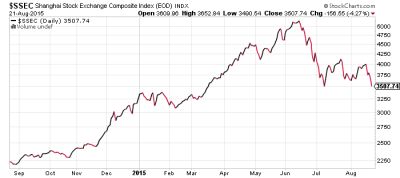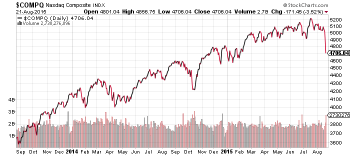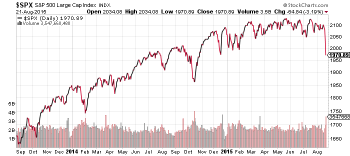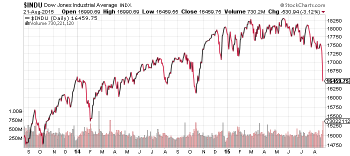
China and the U.S. Treasury Bond Market: the Investment Threat Nobody’s Talking About
by Crista Huff, August 23, 2015
The Chinese economy is on the rocks. The country’s reported annual GDP growth has been falling for five years, which has led to falling commodity prices as demand wanes. In turn, China devalued its currency — the yuan — in an attempt to increase the domestic economy by making foreign goods more expensive to Chinese consumers.
The ripple effects are myriad, with other countries also devaluing their own currencies; and various stock markets falling, due to the effects of lower corporate revenues from commerce with China. Commodity producers — energy, chemicals, and metals — from Texas to Dubai, are among the hardest hit. Falling commodity prices are a natural result of a contracting economy. Right now, the economic contraction in China is the tail wagging a very big dog.
On August 17th, I wrote about Chinese economic and currency problems in How the State-Controlled Chinese Economy Affects Your U.S. Stock Market Investments. The falling Chinese stock market is actually somewhat unrelated to its economy, because the Chinese stock market is more about gambling, and less about investing. Nevertheless, the pullback in the Chinese stock market exacerbates the country’s economic problems, because those investors now have less money available to purchase goods and services.
The devaluation of the yuan makes it harder for foreign countries to competitively sell their products in China. Some emerging economies, including Vietnam, have chosen to follow suit by devaluing their own currencies, in order to maintain commerce levels with China.
Stocks of large U.S. companies which export to China are suffering more than those of U.S. companies that predominantly sell their products in Europe and the Americas. Thus, we have more strength in the NASDAQ this year, and troubling weakness in the Dow Jones Industrial Average, with its concentration of multi-national companies.
Sign up to receive my free stock-investing newsletter! —>>
SHANGHAI STOCK EXCHANGE (SSEC)
The Shanghai Stock Exchange rose about 150% from its lows in the summer of 2014 through its peak in June 2015. It’s no wonder it subsequently “crashed”!
All types of investments become wildly volatile when they morph from “investments” into “gambles”. No person can reasonably expect for an investment to double in less than a year, without eventually having a price correction, which is triggered by gamblers taking profits.
Despite this summer’s dramatic volatility, the SSEC is up 57% vs. a year ago, and it’s up 8.44% year-to-date.
I recommend that stock investors stay on the sidelines right now, with regard to Chinese and emerging market stocks. While the chart appears to be showing investors that the SSEC is stabilizing, there are enough ongoing changes in global commodity and currency markets that Chinese stocks could be further affected in the short-term.
RECENT U.S. STOCK MARKET PERFORMANCE
Revenues and profits at the biggest American-based multi-national corporations, as represented within the Dow Jones Industrial Average, are suffering much more than those of most smaller U.S. companies. Thus, the Dow is suffering more than other major U.S. stock markets this year.
The NASDAQ is down -0.63% year-to-date. This market index is performing better than the S&P and the Dow, partly due to the positive effects of a normal market rotation into smaller-cap stocks, and partly because NASDAQ companies are less affected by Chinese goings-on than are larger-cap U.S. stocks.
The index will likely fall to 4550 before stabilizing, where it traded in December & January. If the NASDAQ completes this current market correction with less of a drop than the S&P 500 and the Dow, then investors can expect the NASDAQ to also rebound more quickly than those other market indices.
Risk-tolerant investors should allocate some of their stock-market investments into small- and mid-cap mutual funds, for the best opportunity to capitalize on the eventual stock market rebound.
All three 2015 Goodfellow LLC model portfolios are beating the markets!
The S&P 500 index is down -4.27% year-to-date. If the S&P does not immediately stabilize around 1980, I expect it to fall to about 1900, before stabilizing.
Most growth stock investors should reallocate mutual fund assets away from blue chip growth & income stocks into large-cap stocks, to better reduce volatility and increase capital gain opportunities. This suggestion pertains specifically to current market trends, and is not meant to suggest that such a move should be permanent.
The Dow Jones Industrial Average, which is the weakest of these three U.S. market averages right now, is down -7.65% year-to-date.
I do not foresee the Dow rebounding quickly. Stock price trends move in synch with earnings projections. Since many Dow stocks will inevitably be lowering their earnings expectations in the coming months, due to lower revenues & profits from Chinese commerce, it would follow that their stock prices will continue to ratchet downwards. Minimally, investors will want to see the Dow stabilize before considering “buying low”.
DON’T IGNORE CHINESE OWNERSHIP OF U.S. TREASURY BONDS
On July 6th, I wrote an article, Managing Bond Investments As Interest Rates Rise. In that article, I made it clear that the long-term trend of falling interest rates was about to reverse. The Federal Open Market Committee (FOMC) has outlined plans to begin raising interest rates by December 2015.
Bonds don’t have complicated, seemingly whimsical trading patterns, like stocks do. Bonds go up and down with much longer-term consistency, based directly upon interest rate trends. Bond prices and interest rates work like a seesaw: when interest rates rise, prices drop, and vice versa.
Chinese ownership of U.S. Treasury bonds stood at 7.2% last October, according to Mike Patton (Forbes), with total foreign ownership of Treasuries at 34.4%. “The worst case would materialize if the largest holders decided to sell their Treasury securities at the same time,” writes Mr. Patton.
Let’s talk about that. There are several reasons that China might sell U.S. Treasuries. And make no mistake — such an action could cause a big bond market correction, the likes of which we haven’t seen since 1994. (See my reference to the ’94 U.S. Treasury bond market in Another Awesome Down Market.)
China might sell any or all of its U.S. Treasury bonds, creating a complete uproar within that market.
There’s no further upside in the price of Treasury bonds. China might therefore sell the bonds, and redeploy cash into domestic projects, real estate, or monetary investments. Any trading-oriented person would do that, so why wouldn’t China? I would certainly be cashing in bonds right now!
It should additionally be noted that the Chinese are well-aware of their power to plummet the Treasury market, which would dramatically harm the U.S., and further shake up economies all over the globe. It would be an act of terrorism for China to sell its Treasury holdings.
WHAT TO DO WITH BOND INVESTMENTS
As I outlined last month in Managing Bond Investments As Interest Rates Rise, there are simple steps that investors can take to protect themselves from the worst of any falling bond market. There’s advice in that article for both investors who own individual bonds — corporate, municipal, or U.S. Treasury — and mutual fund investors.
Regardless of China’s potential actions, the only bond ownership that I would advocate, as we enter a period of rising interest rates, is a short-term laddered portfolio strategy.
To protect yourself further from China’s actions, I suggest moving from Treasury bonds into corporate bonds, municipal bonds, and/or CD’s. Those bond markets will not suffer in tandem with the U.S. Treasury bond market, if China sells its bonds. You might see those alternate bond markets fall, or you might even see them rise, as investors sell their Treasuries during any potential bond market upheaval, and reinvest their capital in other types of bonds.
RESOURCES
How the State-Controlled Chinese Economy Affects Your U.S. Stock Market Investments –– Crista Huff, Aug. 17, 2015
Economic & Stock Market Commentary — August 12, 2015 — Crista Huff, Aug. 12, 2015
The 2015 Chinese Stock Market Correction: A Tutorial — Crista Huff, July 8, 2015
Managing Bond Investments As Interest Rates Rise — Crista Huff, July 6, 2015
Who Owns The Most U.S. Debt? — Forbes, Oct. 28, 2014
Another Awesome Down Market — Crista Huff, Dec. 15, 2014
* * * * *
Goodfellow LLC is a subscription-based stock market website. Stock portfolio investors pay an annual fee to read my articles, which help them profitably navigate the U.S. stock markets, with the goal of outperforming the U.S. stock market indices.
I use a combination of strict fundamental and technical criteria to choose the stocks that receive buy ratings from Goodfellow LLC. Each facet of my investment criteria serves to lower the risk associated with stock investing. My investment strategy works — year in and year out.
Eight of the ten 2012-2014 Goodfellow LLC model portfolios
outperformed the market averages by margins of 50-100% and more!
Subscribe now, and begin improving your investment portfolio returns today!
Send questions and comments to research@goodfellowllc.com.
Happy investing!
Crista Huff
President
Goodfellow LLC
* * * * *
Investment Disclaimer
Release of Liability: Through use of this website viewing or using you agree to hold www.GoodfellowLLC.com and its employees harmless and to completely release www.GoodfellowLLC.com and its employees from any and all liability due to any and all loss (monetary or otherwise), damage (monetary or otherwise), or injury (monetary or otherwise) that you may incur.
Goodfellow LLC and its employees are not paid by third parties to promote nor disparage any investment. Recommendations are based on hypothetical situations of what we would do, not advice on what you should do.
Neither Goodfellow LLC nor its employees are licensed investment advisors, tax advisors, nor attorneys. Consult with a licensed investment advisor and a tax advisor to determine the suitability of any investment.
The information provided herein is obtained from sources believed to be reliable but is not guaranteed as to accuracy or completeness. When information is provided herein from third parties — such as financial news outlets, financial websites, investment firms, or any other source of financial information – the reliability or completeness of such financial information cannot be guaranteed.
The information contained on this website is provided for informational purposes only and contains no investment advice or recommendations to buy or sell any specific securities. This is not an offer or solicitation for any particular trading strategy, or confirmation of any transaction. Statements made on the website are based on the authors’ opinions and based on information available at the time this page was published. The creators are not liable for any errors, omissions or misstatements. Any performance data quoted represents past performance and past performance is not a guarantee of future results. Investments always have a degree of risk, including the potential risk of the loss of the investor’s entire principal. There is no guarantee against any loss.












U.S. Treasuries are anything but immune to International disturbances. The question as to whether or not China will dump additional Treasury holdings is complex. It begins with the question as to why they are holding such a large portfolio in the first place, approximately $1.3 trillion. Is the reason to build a conservative balanced portfolio or invest in ‘political capital’? To sell in large quantities while markets are in a highly volatile condition would give them the ability, of course, to seize some control of U.S. monetary policy. And, does China “need” dollars? A massive selloff would further depreciate the yuan/Renminbi boosting exports to an even greater extent. (China accounts for approximately 15 % of the world economic output. ) Another pertinent question is: How interested is China in joining the IMF? In order for the yuan/Renminbi to be included as a reserve currency, China will have to play nice in the economic schoolyard.